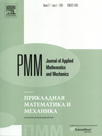 | | Journal of Applied
Mathematics and Mechanics
Russian Academy of Sciences | | Founded
in January 1936
(Translated from 1958)
Issued 6 times a year
ISSN 0021-8928
(print version) |
Archive of Issues
| Total articles in the database: | | 10482 |
| In Russian (Ï̀̀): | | 9683
|
| In English (J. Appl. Math. Mech.): | | 799 |
|
| << Previous article | Volume 77, Issue 4 / 2013 | Next article >> |
| S.Ye. Perelyayev, "New kinematic parameters of the finite rotation of a rigid body," J. Appl. Math. Mech. 77 (4), 380-385 (2013) |
| Year |
2013 |
Volume |
77 |
Issue |
4 |
Pages |
380-385 |
| Title |
New kinematic parameters of the finite rotation of a rigid body |
| Author(s) |
S.Ye. Perelyayev (Moscow, Russia, pers2030@yandex.ru) |
| Abstract |
A new family of kinematic parameters for the orientation of a rigid body (global and local) is presented and described. All the kinematic parameters are obtained by mapping the variables onto a corresponding orientated subspace (hyperplane). In particular, a method of stereographically projecting a point belonging to a five-dimensional sphere S5⊂R6 onto an orientated hyperplane R5 is demonstrated in the case of the classical direction cosines of the angles specifying the orientation of two systems of coordinates. A family of global kinematic parameters is described, obtained by mapping the Hopf five-dimensional kinematic parameters defined in the space R5 onto a four-dimensional orientated subspace R4. A correspondence between the five-dimensional and four-dimensional kinematic parameters defined in the corresponding spaces is established on the basis of a theorem on the homeomorphism of two topological spaces (a four-dimensional sphere S4⊂R5 with one deleted point and an orientated hyperplane in R4). It is also shown to which global four-dimensional orientation parameters–quaternions defined in the space R4 the classical local parameters, that is, the three-dimensional Rodrigues and Gibbs finite rotation vectors, correspond. The kinematic differential rotational equations corresponding to the five-dimensional and four-dimensional orientation parameters are obtained by the projection method. All the rigid body kinematic orientation parameters enable one, using the kinematic equations corresponding to them, to solve the classical Darboux problem, that is, to determine the actual angular position of a body in a three-dimensional space using the known (measured) angular velocity of rotation of the object and its specified initial position. |
| Received |
21 February 2012 |
| Link to Fulltext |
|
| << Previous article | Volume 77, Issue 4 / 2013 | Next article >> |
|
 If you find a misprint on a webpage, please help us correct it promptly - just highlight and press Ctrl+Enter If you find a misprint on a webpage, please help us correct it promptly - just highlight and press Ctrl+Enter
|
|

 Russian
Russian  English
English